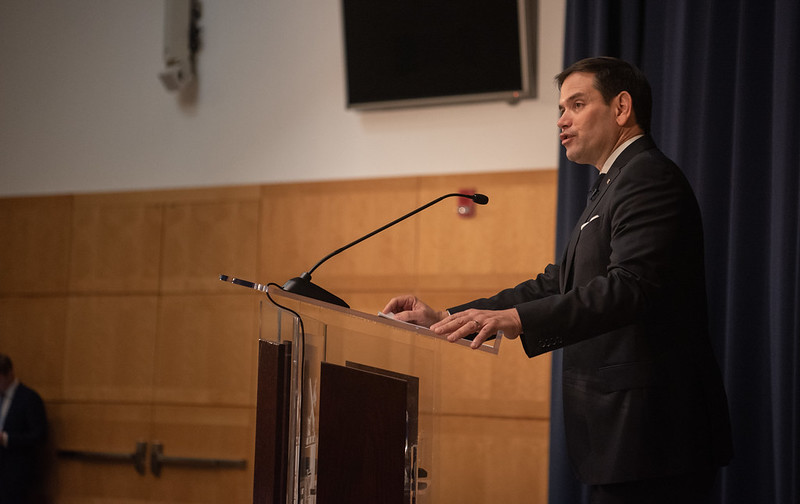Can Congress Work Together to Calm the Country?
The numerous layers of this crisis to which Congress must respond grow daily, and some have more barriers to bipartisanship than others.

Published by The Lawfare Institute
in Cooperation With

As demonstrations involving both peaceful protesters and violent provocateurs and looters continue in major cities around the country, President Trump has responded with inflammatory and divisive rhetoric. On Monday, he criticized and insulted governors for not using more force. On Tuesday, he threatened to invoke the Insurrection Act, and moved to deploy “thousands and thousands” of heavily armed soldiers to Washington, D.C. Immediately following that speech, federal police tear-gassed peaceful protesters outside the White House in order to clear a path for Trump to stage a photo op in front of a church.
With a president apparently bent on escalating tensions, the country needs a resolved legislative response. While there are plenty of members piling on divisive and escalatory rhetoric—Tom Cotton and Matt Gaetz being recent notable examples—there are nonetheless glimmers of hope for a constructive bipartisan response. This type of reaction is still possible, though it may ultimately be limited in scope and effect.
The numerous layers of this crisis to which Congress must respond grow daily, and some have more barriers to bipartisanship than others.
To begin, there is the underlying issue of the use of force by police against racial minorities that led to the death of George Floyd and the background conditions of racial disparity that tolerate and encourage police brutality and racial profiling. Here, there is some—admittedly small—cause for optimism in Congress, including plans in the works on Capitol Hill that have the potential for broad bipartisan support. For example, the chair of the House Judiciary Committee, Jerry Nadler, said he is looking at taking up legislation to establish a commission to investigate racial disparities in education, criminal justice and other policy areas. Republican Sen. Marco Rubio introduced similar legislation on the Senate side last year. Similarly, the chair of the Senate Judiciary Committee, Lindsey Graham, has said he will consider proposals to improve policing, combat “racial discrimination regarding the use of force,” and improve relations between police departments and communities. Graham said that he and Dianne Feinstein, the committee’s ranking Democrat, were both “appalled” at what happened to Floyd and that they intend to “shine a bright light on the problems associated with Mr. Floyd’s death.”
There is also a need for congressional action to respond to the disproportionate use of violent tactics by police, including federal law enforcement officers apparently acting at the direction of the White House, against peaceful protesters. And there is an urgent need for oversight over the president’s and the administration’s disjointed and counterproductive response. Here, the picture is dimmer. Some nascent oversight of the administration’s response—including investigating the U.S. Secret Service’s treatment of protesters outside the White House on Monday—has begun, but it is unclear whether that will gain bipartisan support. Despite global outrage at yesterday’s police violence in D.C., only a few congressional Republicans have condemned attacks on peaceful protesters. Republicans in Congress have remained notably silent, at least publicly, on the president’s tweets and rhetoric. Even where there might be bipartisan opportunity to address use of excessive force against peaceful protesters—an issue that in recent memory lawmakers would have condemned in near-universal voice—members appear significantly divided on how to understand and address bad actors exploiting the protests to introduce violence and property crime. Likewise, no legislative consensus has emerged on how to respond either to Trump’s threats to invoke the Insurrection Act or to his legally empty claim that he will be designating “Antifa” as a terrorist organization.
All of these efforts, aimed at both the underlying systematic issues of police brutality against minorities and the immediate concerns of how to respond to current protests, will require substantial time, legislative energy and political capital. Whether any can garner sustained bipartisan support is a serious question. But Congress should try.
There is at least one place where bipartisanship can play a constructive role right now: accurately representing relevant intelligence reporting. Press accounts have begun to emerge that there are both domestic and foreign disinformation efforts designed to use the current crisis to sow further distrust and divide Americans. Rubio, who is the new chair of the Senate Select Committee on Intelligence, warned on May 31 that foreign adversaries were ramping up activity related to the protests:
Tonight seeing VERY heavy social media activity on #protests & counter reactions from social media accounts linked to at least 3 foreign adversaries.
— Marco Rubio (@marcorubio) May 31, 2020
They didn’t create these divisions. But they are actively stoking & promoting violence & confrontation from multiple angles.
It is hard to say exactly what information the tweet is based on, but it comports with reports that federal officials are looking into a surge of social media accounts with fewer than 200 followers that have been created in the past month—a potential sign of a disinformation effort. As the New York Times points out, there is a history of foreign adversaries using disinformation to exploit racial unrest. In 2016, Russia used a fake Black Lives Matter page on Facebook to spread confusion and stoke anger regarding the death of Philando Castile in a suburb of Minneapolis. In 2015, a Russian-linked ad ran on Facebook following the 2015 riots over the death of Freddie Gray at the hands of police—a move later described by legislators as part of a campaign to stir tensions in the United States around race, police and politics. The Senate Intelligence Committee’s report “Russian Active Measures Campaigns and Interference in the 2016 U.S. Election” catalogues Russian efforts in particular, but government officials and social media companies have made clear that other foreign adversaries engage in similar conduct against the United States.
In addition to the risk that foreign adversaries will artificially fuel divisions as they’ve done in the past, the converse risk is also present in the current situation. There is concern that overstating the degree and impact of foreign disinformation could be used to diminish and minimize the legitimate grievances of very real Americans—people who are taking to the streets amid a global pandemic not because of Russia bots but because of painful lived experience.
So how could we get closer to actually understanding the genuine scope of pernicious foreign activity targeting recent online activist movements?
There are vanishingly few places left with institutional credibility. The newly confirmed director of national intelligence, John Ratcliffe, certainly garners no faith, and both Republicans and Democrats have reason to distrust representations from the various intelligence agencies and even the Department of Defense. Certainly, the White House is not a reliable source. And individual members of Congress, like Rubio in his tweet, are dismissed as party apparatchiks on such matters. But Rubio is not just an individual senator with a Twitter account. He is also the chair of the Senate Intelligence Committee. And he has a powerful potential partner in ranking Democrat Mark Warner—who often paired with Rubio’s predecessor, Richard Burr, to make strong bipartisan statements on matters related to intelligence and Russian interference in the 2016 election. To the extent Rubio and Warner are able to issue factual, responsible statements about intelligence information the American people need to be aware of, that is still a vehicle with genuine institutional legitimacy.
To be sure, this is a small piece of an immensely fraught and complicated picture. But Congress has to start somewhere, and Rubio and Warner together have an opportunity to lead their fellow members by example.






